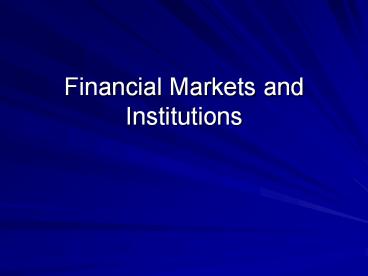Financial Market and Institutions (1) PowerPoint PPT Presentation
Title: Financial Market and Institutions (1)
1
Financial Markets and Institutions
2
Summary of Classification of Financial Markets
- Classification by nature of claim.
- Debt market Equity market
- Classification by maturity of claim.
- Money market Capital market
- Classification by seasoning of claim.
- Primary market Secondary market
- Classification by immediate delivery or future
delivery - Cash or spot market Derivative market. Stock
Recommendations - Classification by organizational structure
- Auction market Over-the-counter market
Intermediated market
3
Financial Instruments and Markets
- Primary Markets
- Market for issuing a new security and
distributing to saver-lenders. - Investment BanksInformation and marketing
specialists for newly issued securities. - Secondary Markets
- Market where existing securities can be exchanged
- New York Stock Exchange
- American Stock Exchange
- Over-the-counter (OTC) markets
4
Types of Corporate Stock
- Preferred Stock
- Fixed dividends, priority over common stock
- Common Stock
- Variable dividends, based on companys profits.
- Convertible
- Preferred stock that can be converted into common
stock at a stated price
5
Measures of Trends in Common Stock Prices
- Standard Poors 500 Stock Index
- Based on prices of 500 individual stocks
- NASDAQ Composite Index
- Based on all stocks listed in Exchanges
- Dow Jones Industrial Average
- Based on price of 30 blue-chip stocks
6
Options and Futures Contracts
- Contractual agreement between two parties to
exchange an asset in the future at a stated price - Derivative financial instruments
- Derive value from underlying assets
- Long
- Buyer of the contract, receive commodity in the
future - Short
- Seller of the contract, provide commodity in the
future - Speculators
- Gamble on price fluctuations and hope to profit
- Hedgers
- Eliminate the risk of price fluctuations
7
The Capital Market
- Exchange of long-term securitiesin excess of one
year - Generally used to secure long-term financing for
capital investment - Stock marketLargest part of capital market and
held by private and institutional investors - Corporate bond marketHeld by insurance
companies, pension and retirement funds - Local and state government bondsPrimarily held
for tax-exempt feature - Government securitiesHeld by commercial banks,
the Fed, individual Americans/foreigners, and
dealers
8
Role of Financial Intermediaries
- Act as agents in transferring funds from
savers-lenders to borrowers-spenders. - Acquire funds by issuing their liabilities to
public and use money to purchase financial assets - Earn profits on difference between interest paid
and earned - Diversify portfolios and minimize risk
- Providing MCX free tips to commodity traders
- Competition lowers interest ratesbeneficial to
economic growth
9
Economic Functions of Financial Markets
- Interactions of buyers and sellers determines
price. - Price discovery process.
- Provides a mechanism to sell.
- Liquidity.
- Reduces transactions costs.
- Search costs.
- Information costs.
10
Commercial Banks
- Most prominent financial institution
- Range in size from huge (BankAmerica) to small
(local banks) - Major sources of funds
- used to be demand deposits of public
- now rely more on other liabilities
- also accept savings and time deposits
- Uses of funds
- short-term government securities
- long-term business loans
- home mortgages
11
Pension and Retirement Funds
- Concerned with long run
- Receive funds from working individuals building
nest-egg - Accurate prediction of future use of funds
- Invest mainly in long-term corporate bonds and
high-grade stock
12
Mutual Funds
- Stock or bond market related institutions
- Pool funds from many people
- Invest in wide variety of securitiesminimize
risk
13
Commercial and Consumer Finance Companies
- Acquire funds primarily by selling short term
loans (commercial paper) - Lend money for consumer purchases or business
firms to finance inventories

